Haohong Lin
CrashAgent: Crash Scenario Generation via Multi-modal Reasoning
May 23, 2025



Abstract:Training and evaluating autonomous driving algorithms requires a diverse range of scenarios. However, most available datasets predominantly consist of normal driving behaviors demonstrated by human drivers, resulting in a limited number of safety-critical cases. This imbalance, often referred to as a long-tail distribution, restricts the ability of driving algorithms to learn from crucial scenarios involving risk or failure, scenarios that are essential for humans to develop driving skills efficiently. To generate such scenarios, we utilize Multi-modal Large Language Models to convert crash reports of accidents into a structured scenario format, which can be directly executed within simulations. Specifically, we introduce CrashAgent, a multi-agent framework designed to interpret multi-modal real-world traffic crash reports for the generation of both road layouts and the behaviors of the ego vehicle and surrounding traffic participants. We comprehensively evaluate the generated crash scenarios from multiple perspectives, including the accuracy of layout reconstruction, collision rate, and diversity. The resulting high-quality and large-scale crash dataset will be publicly available to support the development of safe driving algorithms in handling safety-critical situations.
Causal Composition Diffusion Model for Closed-loop Traffic Generation
Dec 23, 2024Abstract:Simulation is critical for safety evaluation in autonomous driving, particularly in capturing complex interactive behaviors. However, generating realistic and controllable traffic scenarios in long-tail situations remains a significant challenge. Existing generative models suffer from the conflicting objective between user-defined controllability and realism constraints, which is amplified in safety-critical contexts. In this work, we introduce the Causal Compositional Diffusion Model (CCDiff), a structure-guided diffusion framework to address these challenges. We first formulate the learning of controllable and realistic closed-loop simulation as a constrained optimization problem. Then, CCDiff maximizes controllability while adhering to realism by automatically identifying and injecting causal structures directly into the diffusion process, providing structured guidance to enhance both realism and controllability. Through rigorous evaluations on benchmark datasets and in a closed-loop simulator, CCDiff demonstrates substantial gains over state-of-the-art approaches in generating realistic and user-preferred trajectories. Our results show CCDiff's effectiveness in extracting and leveraging causal structures, showing improved closed-loop performance based on key metrics such as collision rate, off-road rate, FDE, and comfort.
OASIS: Conditional Distribution Shaping for Offline Safe Reinforcement Learning
Jul 19, 2024



Abstract:Offline safe reinforcement learning (RL) aims to train a policy that satisfies constraints using a pre-collected dataset. Most current methods struggle with the mismatch between imperfect demonstrations and the desired safe and rewarding performance. In this paper, we introduce OASIS (cOnditionAl diStributIon Shaping), a new paradigm in offline safe RL designed to overcome these critical limitations. OASIS utilizes a conditional diffusion model to synthesize offline datasets, thus shaping the data distribution toward a beneficial target domain. Our approach makes compliance with safety constraints through effective data utilization and regularization techniques to benefit offline safe RL training. Comprehensive evaluations on public benchmarks and varying datasets showcase OASIS's superiority in benefiting offline safe RL agents to achieve high-reward behavior while satisfying the safety constraints, outperforming established baselines. Furthermore, OASIS exhibits high data efficiency and robustness, making it suitable for real-world applications, particularly in tasks where safety is imperative and high-quality demonstrations are scarce.
BECAUSE: Bilinear Causal Representation for Generalizable Offline Model-based Reinforcement Learning
Jul 15, 2024



Abstract:Offline model-based reinforcement learning (MBRL) enhances data efficiency by utilizing pre-collected datasets to learn models and policies, especially in scenarios where exploration is costly or infeasible. Nevertheless, its performance often suffers from the objective mismatch between model and policy learning, resulting in inferior performance despite accurate model predictions. This paper first identifies the primary source of this mismatch comes from the underlying confounders present in offline data for MBRL. Subsequently, we introduce \textbf{B}ilin\textbf{E}ar \textbf{CAUS}al r\textbf{E}presentation~(BECAUSE), an algorithm to capture causal representation for both states and actions to reduce the influence of the distribution shift, thus mitigating the objective mismatch problem. Comprehensive evaluations on 18 tasks that vary in data quality and environment context demonstrate the superior performance of BECAUSE over existing offline RL algorithms. We show the generalizability and robustness of BECAUSE under fewer samples or larger numbers of confounders. Additionally, we offer theoretical analysis of BECAUSE to prove its error bound and sample efficiency when integrating causal representation into offline MBRL.
Generalize by Touching: Tactile Ensemble Skill Transfer for Robotic Furniture Assembly
Apr 26, 2024Abstract:Furniture assembly remains an unsolved problem in robotic manipulation due to its long task horizon and nongeneralizable operations plan. This paper presents the Tactile Ensemble Skill Transfer (TEST) framework, a pioneering offline reinforcement learning (RL) approach that incorporates tactile feedback in the control loop. TEST's core design is to learn a skill transition model for high-level planning, along with a set of adaptive intra-skill goal-reaching policies. Such design aims to solve the robotic furniture assembly problem in a more generalizable way, facilitating seamless chaining of skills for this long-horizon task. We first sample demonstration from a set of heuristic policies and trajectories consisting of a set of randomized sub-skill segments, enabling the acquisition of rich robot trajectories that capture skill stages, robot states, visual indicators, and crucially, tactile signals. Leveraging these trajectories, our offline RL method discerns skill termination conditions and coordinates skill transitions. Our evaluations highlight the proficiency of TEST on the in-distribution furniture assemblies, its adaptability to unseen furniture configurations, and its robustness against visual disturbances. Ablation studies further accentuate the pivotal role of two algorithmic components: the skill transition model and tactile ensemble policies. Results indicate that TEST can achieve a success rate of 90\% and is over 4 times more efficient than the heuristic policy in both in-distribution and generalization settings, suggesting a scalable skill transfer approach for contact-rich manipulation.
Safety-aware Causal Representation for Trustworthy Reinforcement Learning in Autonomous Driving
Oct 31, 2023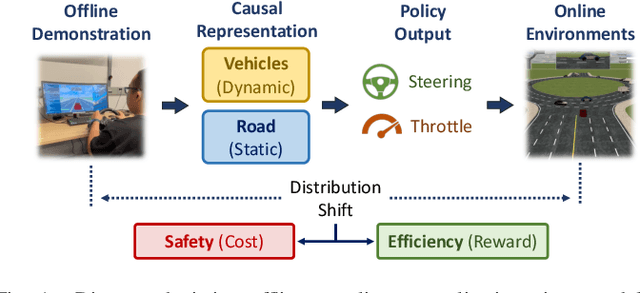

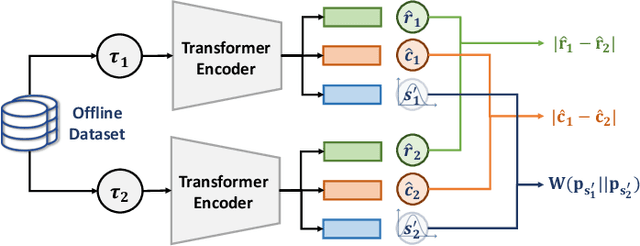
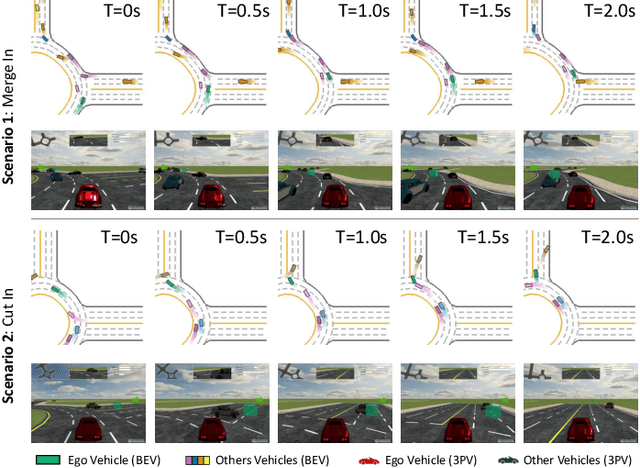
Abstract:In the domain of autonomous driving, the Learning from Demonstration (LfD) paradigm has exhibited notable efficacy in addressing sequential decision-making problems. However, consistently achieving safety in varying traffic contexts, especially in safety-critical scenarios, poses a significant challenge due to the long-tailed and unforeseen scenarios absent from offline datasets. In this paper, we introduce the saFety-aware strUctured Scenario representatION (FUSION), a pioneering methodology conceived to facilitate the learning of an adaptive end-to-end driving policy by leveraging structured scenario information. FUSION capitalizes on the causal relationships between decomposed reward, cost, state, and action space, constructing a framework for structured sequential reasoning under dynamic traffic environments. We conduct rigorous evaluations in two typical real-world settings of distribution shift in autonomous vehicles, demonstrating the good balance between safety cost and utility reward of FUSION compared to contemporary state-of-the-art safety-aware LfD baselines. Empirical evidence under diverse driving scenarios attests that FUSION significantly enhances the safety and generalizability of autonomous driving agents, even in the face of challenging and unseen environments. Furthermore, our ablation studies reveal noticeable improvements in the integration of causal representation into the safe offline RL problem.
Datasets and Benchmarks for Offline Safe Reinforcement Learning
Jun 16, 2023



Abstract:This paper presents a comprehensive benchmarking suite tailored to offline safe reinforcement learning (RL) challenges, aiming to foster progress in the development and evaluation of safe learning algorithms in both the training and deployment phases. Our benchmark suite contains three packages: 1) expertly crafted safe policies, 2) D4RL-styled datasets along with environment wrappers, and 3) high-quality offline safe RL baseline implementations. We feature a methodical data collection pipeline powered by advanced safe RL algorithms, which facilitates the generation of diverse datasets across 38 popular safe RL tasks, from robot control to autonomous driving. We further introduce an array of data post-processing filters, capable of modifying each dataset's diversity, thereby simulating various data collection conditions. Additionally, we provide elegant and extensible implementations of prevalent offline safe RL algorithms to accelerate research in this area. Through extensive experiments with over 50000 CPU and 800 GPU hours of computations, we evaluate and compare the performance of these baseline algorithms on the collected datasets, offering insights into their strengths, limitations, and potential areas of improvement. Our benchmarking framework serves as a valuable resource for researchers and practitioners, facilitating the development of more robust and reliable offline safe RL solutions in safety-critical applications. The benchmark website is available at \url{www.offline-saferl.org}.
Generalizing Goal-Conditioned Reinforcement Learning with Variational Causal Reasoning
Jul 19, 2022



Abstract:As a pivotal component to attaining generalizable solutions in human intelligence, reasoning provides great potential for reinforcement learning (RL) agents' generalization towards varied goals by summarizing part-to-whole arguments and discovering cause-and-effect relations. However, how to discover and represent causalities remains a huge gap that hinders the development of causal RL. In this paper, we augment Goal-Conditioned RL (GCRL) with Causal Graph (CG), a structure built upon the relation between objects and events. We novelly formulate the GCRL problem into variational likelihood maximization with CG as latent variables. To optimize the derived objective, we propose a framework with theoretical performance guarantees that alternates between two steps: using interventional data to estimate the posterior of CG; using CG to learn generalizable models and interpretable policies. Due to the lack of public benchmarks that verify generalization capability under reasoning, we design nine tasks and then empirically show the effectiveness of the proposed method against five baselines on these tasks. Further theoretical analysis shows that our performance improvement is attributed to the virtuous cycle of causal discovery, transition modeling, and policy training, which aligns with the experimental evidence in extensive ablation studies.
A Survey on Safety-Critical Scenario Generation for Autonomous Driving -- A Methodological Perspective
Feb 07, 2022
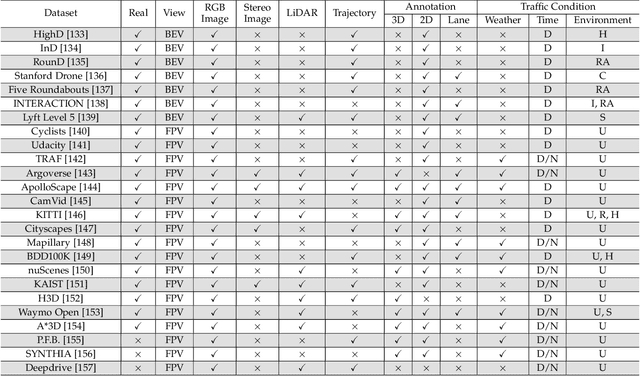
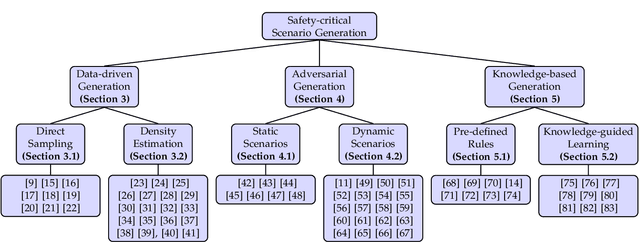
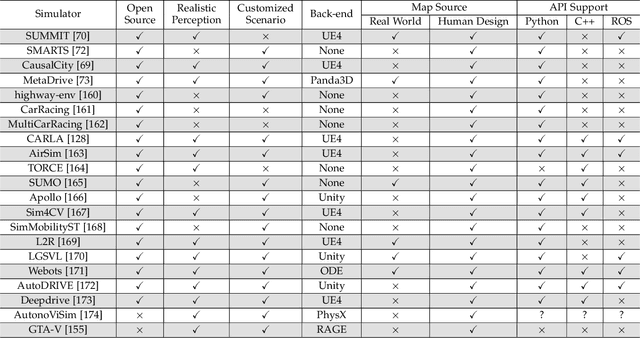
Abstract:Autonomous driving systems have witnessed a great development during the past years thanks to the advance in sensing and decision-making. One critical obstacle for their massive deployment in the real world is the evaluation of safety. Most existing driving systems are still trained and evaluated on naturalistic scenarios that account for the vast majority of daily life or heuristically-generated adversarial ones. However, the large population of cars requires an extremely low collision rate, indicating safety-critical scenarios collected in the real world would be rare. Thus, methods to artificially generate artificial scenarios becomes critical to manage the risk and reduce the cost. In this survey, we focus on the algorithms of safety-critical scenario generation. We firstly provide a comprehensive taxonomy of existing algorithms by dividing them into three categories: data-driven generation, adversarial generation, and knowledge-based generation. Then, we discuss useful tools for scenario generation, including simulation platforms and packages. Finally, we extend our discussion to five main challenges of current works -- fidelity, efficiency, diversity, transferability, controllability -- and the research opportunities lighted up by these challenges.
CausalAF: Causal Autoregressive Flow for Goal-Directed Safety-Critical Scenes Generation
Oct 26, 2021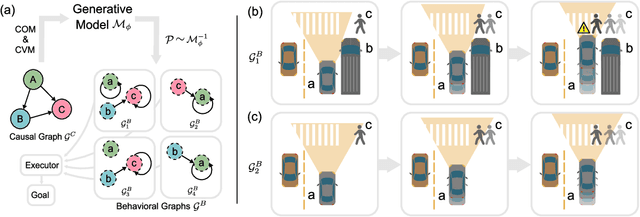
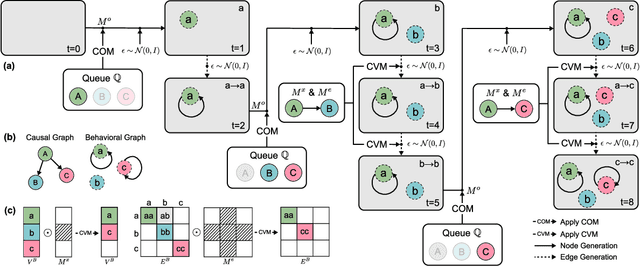

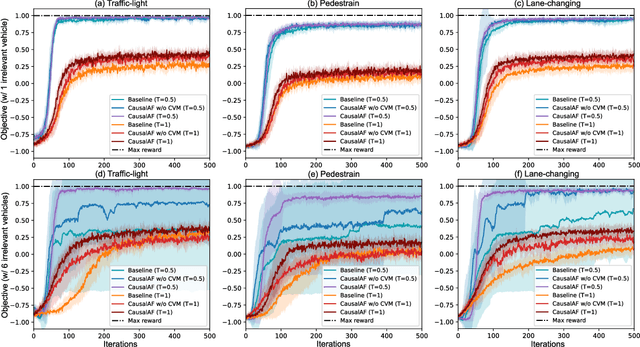
Abstract:Goal-directed generation, aiming for solving downstream tasks by generating diverse data, has a potentially wide range of applications in the real world. Previous works tend to formulate goal-directed generation as a purely data-driven problem, which directly searches or approximates the distribution of samples satisfying the goal. However, the generation ability of preexisting work is heavily restricted by inefficient sampling, especially for sparse goals that rarely show up in off-the-shelf datasets. For instance, generating safety-critical traffic scenes with the goal of increasing the risk of collision is critical to evaluate autonomous vehicles, but the rareness of such scenes is the biggest resistance. In this paper, we integrate causality as a prior into the safety-critical scene generation process and propose a flow-based generative framework - Causal Autoregressive Flow (CausalAF). CausalAF encourages the generative model to uncover and follow the causal relationship among generated objects via novel causal masking operations instead of searching the sample only from observational data. By learning the cause-and-effect mechanism of how the generated scene achieves the goal rather than just learning correlations from data, CausalAF significantly improves the learning efficiency. Extensive experiments on three heterogeneous traffic scenes illustrate that CausalAF requires much fewer optimization resources to effectively generate goal-directed scenes for safety evaluation tasks.
 Add to Chrome
Add to Chrome Add to Firefox
Add to Firefox Add to Edge
Add to Edge